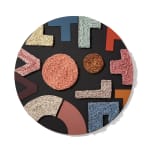


Mimi Joung
What is the late November doing?, Autumn, Home / 고향, 2021
Porcelain and painted fibreboard
85 x 10cm
Series: Home
Signed and dated on reverse
CF0326
Copyright The Artist
Photo: Mimi Joung
Currency:
Further images
Talking about this body of work, Korean artist Mimi Joung said: “This is one of four pieces which are a personal reflection on ‘East Coker’, the second of the Four...
Talking about this body of work, Korean artist Mimi Joung said:
“This is one of four pieces which are a personal reflection on ‘East Coker’, the second of the Four Quartets, written by T S Eliot in 1940. East Coker is both his ancestral family’s home and the place were he was buried. For me, the poem speaks both about the place that we call home and the place where we feel that we belong.
“Each piece contains the poem – hand written with porcelain slip – which is taped into a series of sculptural elements that form the foundation of the work. Each can be seen as an abstract landscape through the different seasons of the year, as well as an abstract interpretation of a human life, through the season’s of our own lives too. In my beginning is my end. Spring is ‘in my beginning’ and the colours are suggestive of blossom, new life and the colours of a child’s bedroom. Summer brings us to ‘In that open field’ – a sense of adventure as we grow and escape into nature, away from our parents and our childhood. ‘What is the late November doing?’ suggests a crisis, a storm, the autumnal night. It becomes a circle of life. We have worked hard, created a family and achieved something, so within this turning point there is also a glint of gold amidst the tempest. In the final piece, ’So here I am’, we reach winter, a quiet time where the land is covered with snow, we rest and prepare for next season. We can see the gentle eye of the child in the old person’s face. In my end is my beginning.
“In Korean, we have a word, Huinoaelag, which means that in every joy there is sorrow, and in every sorrow there is joy. East Coker can be seen as a sombre poem but it is full of life and learning and even a touch of dark humour. I hope that people will see that I had fun making them despite the pessimism in Eliot’s words.
“These pieces are created in memory of my father who knew how to enjoy his life in every season.”
“This is one of four pieces which are a personal reflection on ‘East Coker’, the second of the Four Quartets, written by T S Eliot in 1940. East Coker is both his ancestral family’s home and the place were he was buried. For me, the poem speaks both about the place that we call home and the place where we feel that we belong.
“Each piece contains the poem – hand written with porcelain slip – which is taped into a series of sculptural elements that form the foundation of the work. Each can be seen as an abstract landscape through the different seasons of the year, as well as an abstract interpretation of a human life, through the season’s of our own lives too. In my beginning is my end. Spring is ‘in my beginning’ and the colours are suggestive of blossom, new life and the colours of a child’s bedroom. Summer brings us to ‘In that open field’ – a sense of adventure as we grow and escape into nature, away from our parents and our childhood. ‘What is the late November doing?’ suggests a crisis, a storm, the autumnal night. It becomes a circle of life. We have worked hard, created a family and achieved something, so within this turning point there is also a glint of gold amidst the tempest. In the final piece, ’So here I am’, we reach winter, a quiet time where the land is covered with snow, we rest and prepare for next season. We can see the gentle eye of the child in the old person’s face. In my end is my beginning.
“In Korean, we have a word, Huinoaelag, which means that in every joy there is sorrow, and in every sorrow there is joy. East Coker can be seen as a sombre poem but it is full of life and learning and even a touch of dark humour. I hope that people will see that I had fun making them despite the pessimism in Eliot’s words.
“These pieces are created in memory of my father who knew how to enjoy his life in every season.”


